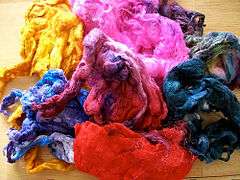Noil

Noil is the short fiber left over from combing wool or spinning silk and used as a decorative additive for many spinning projects, like rovings and yarns.[1][2] Silk noil is also called "raw silk", although that is a misnomer. As noil is a relatively short fiber, fabric made from noil is weaker and considered less valuable.
Silk
Silk noil may also be made from the short fibres, directly sourced from the silkworm cocoons. Rather than the continuous length of silk, shorter fibers, which are generally not used to create high quality silk are used for silk noil, which has a slightly rough texture. It is relatively weaker and has low resilience. It tends to have very low lustre, which makes it appear more like cotton than silk.
Noil silk has the advantage of being made from protein. Thus, it has a better texture and depth that cotton – and gives a nice fall and drape.
Silk noil is also blended or appended with heavier fabrics like velvets and satins to create varied textures. Made out of the strongest natural fibres (with a protein base) around, the Noil Sarees are not slippery like synthetic fibres and absorb moisture well. Noils are easily dyed, and can also be made waterproof, by using a polyurethane coating. This also increases their usage in furnishings industry.
Silk noil hails from China, from where it was exported to Europe in the middle ages, especially to Italy. It was used to create silk blends, through the first half of the 14th century. However, over the time the use decreased.
With an increase in demand and variety of alternatives and low-cost substitutes, Noil has re-surfaced – experiencing a sort of revival. In India, noil is used to make sarees, materials and furnishings.
References
- ↑ Indiana Alpaca Fiber Encyclopedia. Collected 20 Jul 2010
- ↑ Encyclopædia Britannica Volume XXV, 1911 Edition, pp 107. Google Books. Collected 20 Jul 2010
